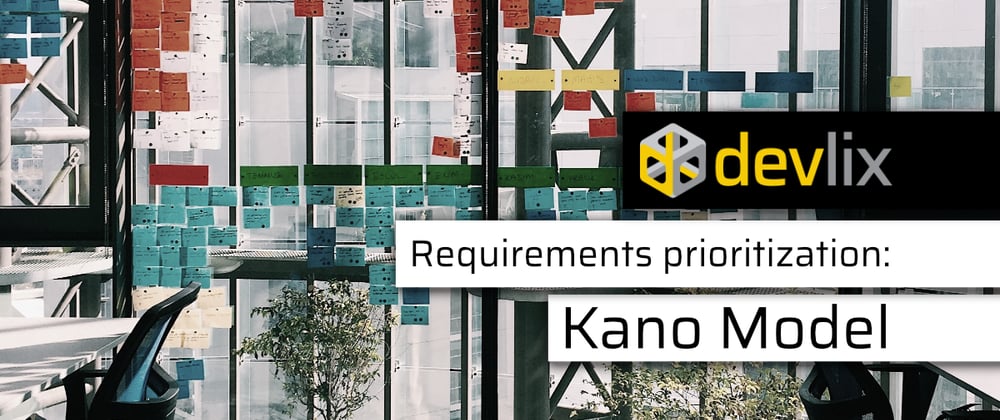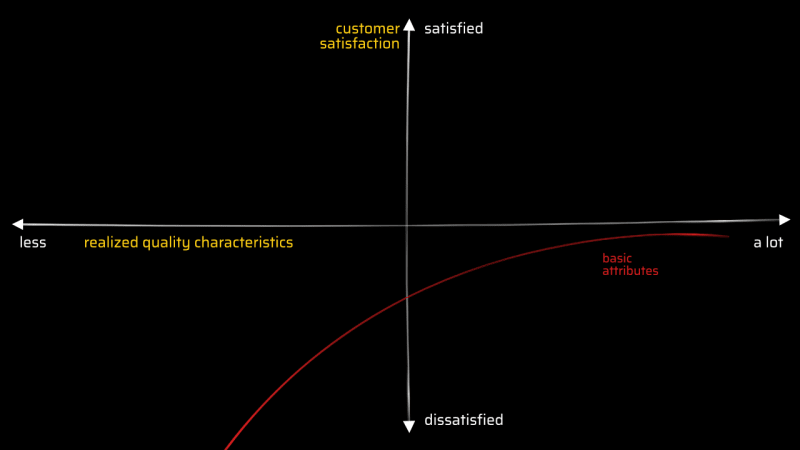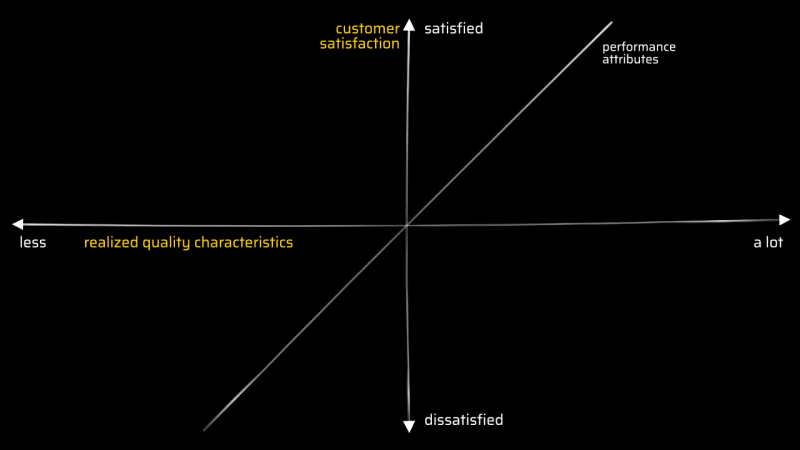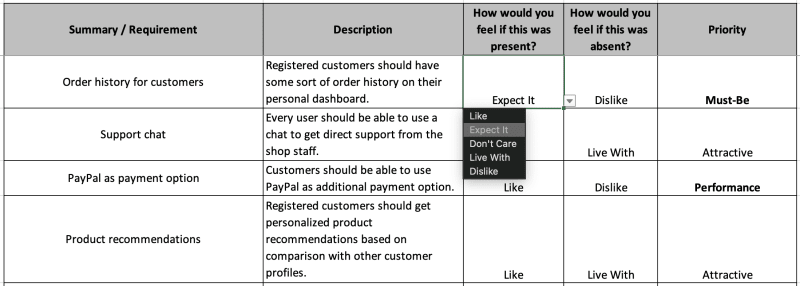After our articles about the MoSCoW method and the more simpler 100 Dollar and Scale methods, today in the third part of our series we would like to talk about another method that is used successfully when it comes to prioritization of requirement pools. The goal of this method is to maximize the customer satisfaction of your product/project or service. We can achieve this by identifying three parameters against which requirements must be measured: Excitement, Performance and Expectation (or basic characteristic).
Noriaki Kano, developer and namesake of the Kano model and former professor of the Tokyo University of Science, tracked the goal of aligning the (further) development of a product and/or a service and the expected customer satisfaction. This is in contrast to the assumption that any further development of a product automatically increases satisfaction.
The model was developed 1978 and is successfully used in the most different ranges of the economy. Also in software development the model is used and should be considered with an upcoming planning for a new or further development of a product.
By the way, Noriaki Kano was inspired by the two-factor theory of Frederick Herzberg, American professor of industrial science, who already in 1959 described the motivators and hygiene factors that have a direct influence on satisfaction and dissatisfaction at the workplace or on the work situation.
Characteristics of a product
The Kano Model describes five attributes that are assigned to functions or requirements of your product/project. The three most important characteristics that we constantly deal with in everyday project work are:
- basic attributes, must-be quality
- performance attributes, one-dimensional quality
- excitement attributes, attractive quality
In addition, there are two features that we do not consider in detail in this article:
- Irrelevant features that are of no concern to the customer, whether they are provided or absent
- Rejection features, which have a negative impact on customer satisfaction if they are present, but a positive impact if they are absent
Before we can classify requirements/features in the three dimensions (Basic, Performance, Excitement), let's have a look what these features mean.
Basic attributes
A question to start with: which functions does your customer expect at least to be able to use your product? The answer should be a list of requirements that must be implemented and which, if missing, will most likely lead to irritation for the user.
As an example, let's consider an online store. Here, a product list, the display of product information and an ordering option are absolutely essential. These functions are to be evaluated (of course on a high level) as basic features and ensure a basic acceptance of the product.
See these features as a foundation on which you can steadily increase satisfaction through the other two attributes/characteristics. A product does not become a success just by providing basic functionality.
Performance attributes
It gets interesting with the possible top performers of your product/project. These are functions or features that make customer satisfaction grow linearly.
To stay with the example of the online store: a sortable and filterable product list contributes just as much to satisfaction as a widely accepted payment method in the ordering process.
These functions don't reinvent the wheel, but they do increase satisfaction enormously - and thus also directly the acceptance of your product.
Excitement attributes
Lastly, let's move on to features that exponentially increase customer satisfaction.
Let's take our online store as an example again: If we present product reviews that not only reflect the opinion of our own customers, but also take into account reviews from external portals or stores, we create more trust in the products we offer. If we offer suitable product recommendations based on a comparison of customer profiles, the customer feels understood and, in the best case, is also grateful for this very product recommendation. This satisfaction is reflected in a higher number of orders.
Whether new functions that no other competitor product offers, or details that make functions unbeatable compared to the competition - they provide the valuable WOW moment, usually exceed expectations and thus inspire the user of your product.
But how do we find out which attribute we can assign to product requirements/functions?
Customer opinions are key
Whether your customers are customers in the sense of buyers in a store or stakeholders who demand functions in your product/project, what is important is their opinion of the planned functions. In this way, we can analyze a possible business value, which in turn helps us prioritize a product backlog.
Did you create personas for your product/project? Use these as well and look at the requirements from the respective perspectives!
How do we now survey our customers to be able to classify requirements and functions into the categories mentioned above?
We help ourselves with a prepared questionnaire, which
- lists and describes requirements/functions for which we would like to get a customer opinion,
- asks two questions about each requirement (positive and negative) and
- allows a classification based on the answers and, in the best case, does this automatically.
As just mentioned, we evaluate two questions:
- How would your customer feel when the named requirement would be provided?
- How would your customer feel when the mentioned requirement would NOT be provided?
Where there are questions, there must be answers. Provide these pre-written answers for voting and customize them if needed:
- I would be very pleased
- I assume that
- I don't care / I don't attach any special importance to it
- I can live with it / I just put up with it
- That would bother me
Here is an example of what your questionnaire could look like:
We achieve a classification of the respective requirement/function by the given answers through a matrix, which is structured like the following example.
Let's take our online store as an example again. In our requirements pool, there is a requirement that describes a chat as a support channel that is to be made available to potential customers for communication with the store's employees. We ask a customer about this:
Question: How would you feel about us providing this feature in the store? Answer: I would like it!
Question: How would you feel if we did NOT provide this feature in the store? Answer: I would not like it!
Now let's take a closer look at the answers. According to the matrix presented, the requirement would represent a performance attribute of your product that contributes to customer satisfaction.
If we now apply this method to all collected requirements, we get a sortable and filterable pool that simplifies further planning and makes the product/project clearer and more tangible. However, this will only succeed if you give the results of such an analysis an appropriate weight and also put them above your personal preferences!
By the way: There are enough templates for questionnaires on the Internet. Adapt them to your needs!
Use this instrument to interview all relevant people for an analysis of your product/project. This will give you a more accurate picture across all personas and stakeholders.
If you have a manageable pool of evaluated requirements/functions, it is also a good idea to visualize the results, for example with a scatter plot. This makes discussions about the results much easier.
Make use of the Kano Modell
You can use the Kano model not only with an existing requirement pool.
Product and service strategies
If you are in a dynamic market with your product or service, which always brings new or changing requirements, you can use the Kano model for a constant and continuous analysis. It is important to keep an eye on the competition. Over time, performance characteristics become basic characteristics, enthusiasm characteristics become performance characteristics. You can use this knowledge for the further development and improvement of your product. Only those who know the requirements and their value for the customers will also keep their customer base in the long term.
Business strategies
If we take a broader view and evaluate our own company products instead of the requirements of a single product, for example, the Kano model can also be used to make strategic decisions about the product portfolio. This is particularly important in competitive market segments.
Ultimately, services, organizational units, etc. can also be evaluated, analyzed, and thus planned in the enterprise environment.
Conclusion
The Kano model has proven itself and we recommend you to try it out for your next product or project! It has helped us especially in the agile environment, because you can outline and determine the scope of an MVP very quickly. If you also carry out an evaluation at regular intervals, a big part of the product backlog prioritization is done.
We also observed that an evaluation of the responses of all the stakeholders involved also gives you the opportunity to interesting discussions that may require subsequent prioritization of the requirements. Fortunately, nothing is set in stone here either.
Adapt questionnaires to your needs and your environment! Do not only interview stakeholders but also present the results to them. Any follow-up discussion based on your analysis is important and valuable. Moreover, this is an elegant way to involve stakeholders in the planning process and thus gain more acceptance for your product or project.
More information about the Kano Model: Kano model - Wikipedia
Frank Schillinger is writing for the devlix Blog at https://www.devlix.de/blog
This article was published first here (german): https://www.devlix.de/priorisierung-mit-dem-kano-modell/
Feature image: Photo by İrfan Simsar on Unsplash














Oldest comments (0)